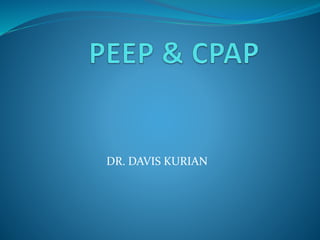Peep & cpap
•Als PPTX, PDF herunterladen•
87 gefällt mir•21,352 views
PEEP AND CPAP - simplified
Melden
Teilen
Melden
Teilen

Empfohlen
Weitere ähnliche Inhalte
Was ist angesagt?
Was ist angesagt? (20)
Ähnlich wie Peep & cpap
Ähnlich wie Peep & cpap (20)
COPD(Chronic Obstructive Pulmonary Disease) a7med-mo7amed

COPD(Chronic Obstructive Pulmonary Disease) a7med-mo7amed
Ventilatory support in special situations balamugesh

Ventilatory support in special situations balamugesh
Mechanical ventilation of bronchial asthma, is it a real dilemma

Mechanical ventilation of bronchial asthma, is it a real dilemma
Mehr von Davis Kurian
Mehr von Davis Kurian (9)
Kürzlich hochgeladen
Mehran University Newsletter is a Quarterly Publication from Public Relations OfficeMehran University Newsletter Vol-X, Issue-I, 2024

Mehran University Newsletter Vol-X, Issue-I, 2024Mehran University of Engineering & Technology, Jamshoro
Kürzlich hochgeladen (20)
This PowerPoint helps students to consider the concept of infinity.

This PowerPoint helps students to consider the concept of infinity.
General Principles of Intellectual Property: Concepts of Intellectual Proper...

General Principles of Intellectual Property: Concepts of Intellectual Proper...
Fostering Friendships - Enhancing Social Bonds in the Classroom

Fostering Friendships - Enhancing Social Bonds in the Classroom
Jual Obat Aborsi Hongkong ( Asli No.1 ) 085657271886 Obat Penggugur Kandungan...

Jual Obat Aborsi Hongkong ( Asli No.1 ) 085657271886 Obat Penggugur Kandungan...
Micro-Scholarship, What it is, How can it help me.pdf

Micro-Scholarship, What it is, How can it help me.pdf
Interdisciplinary_Insights_Data_Collection_Methods.pptx

Interdisciplinary_Insights_Data_Collection_Methods.pptx
Beyond_Borders_Understanding_Anime_and_Manga_Fandom_A_Comprehensive_Audience_...

Beyond_Borders_Understanding_Anime_and_Manga_Fandom_A_Comprehensive_Audience_...
Plant propagation: Sexual and Asexual propapagation.pptx

Plant propagation: Sexual and Asexual propapagation.pptx
Peep & cpap
- 2. FRC (functional residual capacity) :
- 3. Amount of air in the lungs after normal expiration. Dependent on sex, age, height, and weight. FRC goes up with height and age and down with weight and is smaller in women than in men. With increased ventilation, as during exercise, VT is raised by increasing both inspiration and expiration so that FRC is lowered by approx 0.5 L.
- 4. However, in the presence of airway obstruction, as in asthma, for example, expiration is slowed down so that the end-expiratory level is elevated instead of being lowered. This is termed air trapping. FRC increases with old age (loss of elastic tissue) and also in COPD (due to chronic air trapping and more severe loss of elastic tissue). FRC decreases in idiopathic fibrosis, pneumoconiosis, and different forms of granulomatosis and vasculitis.
- 5. PEEP Defined as that positive pressure which is applied during the end of expiration – which increases the end expiratory pressure to more than atmospheric pressure. Often used to improve patient’s oxygen status esp in patients with refractory hypoxemia. Not a stand alone mode.
- 7. Indications of PEEP : 1. Refractory hypoxemia to any cause 2. Intra pulmonary shunts 3. Decreased FRC & lung compliance
- 8. Refractory hypoxemia: Hypoxemia which responds poorly to moderate to high levels of oxygen (FiO2 = 1) Useful clinical guide is a PaO2 -60mm Hg or less at FiO2 = > 0.5
- 9. Intrapulmonary Shunts & hypoxemia : Caused by decreased FRC, atelectasis, V/Q mismatch. Decreased FRC & lung compliance: PEEP, here increases FRC and decreases the work of breathing, hence improves the symptoms.
- 10. PHYSIOLOGY OF PEEP: Positive pressure at the end of expiration -> reinflates the collapsed alveoli -> maintains the alveolar inflation even during expiration -> increases FRC -> improves ventilation. Once the recruitment of these alveoli has occurred, PEEP lowers the alveolar distending pressure and facilitates the gas diffusion and oxygenation.
- 11. Complications of PEEP 1. Decreases venous return 2. Decreased cardiac output 3. Barotrauma 4. Increased intra cranial pressure 5. Alters renal metabolism and water balance
- 12. CPAP : Is actually PEEP applied to a spontaneously breathing person. The indications are those similar to PEEP. Additional requirement being that the patient must have an adequate lung function to sustain the eucapnic ventilation. Methods include face mask, nasal mask, ET tube. Neonates – nasal CPAP is the method of choice
- 13. Classically used in obstructive sleep apnoea. Here it prevents the airway from collapsing. Because of the risk of gastric distension and regurgitation, CPAP masks must be used only in patients with intact airway reflexes and with CPAP levels less than 15 cm H2O.
- 14. Auto PEEP: Incomplete expiration prior to the initiation of the next breath causes progressive air trapping (hyperinflation). This accumulation of air increases alveolar pressure at the end of expiration, which is referred to as auto-PEEP or intrinsic PEEP.
- 15. Auto-PEEP develops commonly in high minute ventilation (hyperventilation), expiratory flow limitation (obstructed airway) and expiratory resistance (narrow airway). The PEEP value range commonly used ranges from 5-10 cm H2O, though the upper limit has been posted at 20 cm H2O. Levels above that is associated with increased incidence of complications especially barotrauma. PEEP is increased at the rate of 2-3cm H2O depending on the clinical condition of the patient.
- 16. Contra indications to the use of PEEP/CPAP: 1. Absolute : Tension pneumothorax 2. Relative : Barotrauma Hypovolemia Increased ICP Preexisiting bullae Recent lung surgeries Unilateral lung disorders